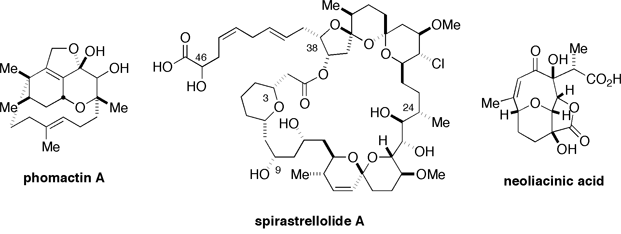Nancy I. Totah

Nancy I. Totah
Associate Professor
CONTACT
Chemistry
3-004 Center for Science and Technology
Email: ntotah@syr.edu
Office: 315.443.2657
PROGRAM AFFILIATIONS
Biochemistry
Biotechnology
Degrees
- B.S., 1984, California Polytechnic State University
- Ph.D., 1990, Yale University
- Postdoctoral Fellow, 1990-1993, Columbia University
Courses Taught
- CHE 276: Organic Chemistry Laboratory
- CHE 325: Organic Chemistry Lecture
- CHE 575: Organic Spectroscopy
- CHE 676: Introduction to Synthesis: Methodology
- CHE 686: Advanced Organic Synthesis: Design
Organic chemistry; new methods development; synthesis of biologically active natural products, asymmetric synthesis
The primary focus of our research program is organic synthesis including the development of new synthetic methods and strategies, and their application to the asymmetric synthesis of natural products. Central to this program is the ability to prepare and characterize complex organic molecules. As such, students in the group are exposed to a broad range of synthetic, mechanistic, and spectroscopic techniques. Conformational analysis and molecular modeling studies also contribute to these activities.
A major component of our research program is the total synthesis of natural products. In particular, we are interested in the preparation of molecules that display interesting biological activity, have challenging structural features, and are found in low natural abundance. One of our current targets, phomactin A, the most complex of a larger class of natural products. This marine fungal metabolite displays a rather unique structural architecture, containing a central oxadecalin core that is bridged by a twelve membered macrocycle. Phomactin A is a specific platelet aggregating factor (PAF) antagonist. As PAF has been associated with a variety of inflammatory, respiratory and cardiovascular diseases, the phomactin template may be useful in the development of new therapeutic agents.
A second synthetic target, spirastrellolide A, shows potent antimitotic activity, and thus has great potential as an anticancer agent. However, while the basic skeletal structure of this compound is known, uncertainty in the stereochemical relationships between the C3-C7, C9-C24, and C27-C38 fragments, as well as with the stereocenter at C46, impede further development of this compound as a therapeutic agent. Synthetic efforts such as our own may help to resolve these stereochemical issues.
Neoliacinic acid, a densely functionalized sesquiterpene natural product, is also a molecule of synthetic interest in our group. This compound shows some cytotoxic activity, though a key attraction of this target is the considerable synthetic challenge inherent to its highly oxygenated, bridged ether skeleton.
In any synthetic endeavor the goal is not only to prepare a given target, but to do so in a manner that is both efficient and aesthetically pleasing. Considering the complexity of many natural products, attempts to meet these criteria often necessitate the development of new synthetic methods. As such, we place significant emphasis on the discovery and development of new reactions and strategies for achieving our synthetic goals. As the true test of a synthetic method is it's utility in the synthesis of a complex chemical system, this area of study complements our program in natural product synthesis. Current areas of investigation include the use of dihydropyrone dienophiles in the Diels-Alder reaction, the use of exocyclic enol ethers as nucleophiles in various carbon-carbon bond forming reactions, and an epoxidation/Grob fragmentation sequence for the synthesis of bridged heterocyclic ring systems.

- James K. Duah-Agyeman Award for Outstanding Faculty, 2012
- National Institutes of Health Postdoctoral Fellowship, 1990-1992
- Old Gold Fellowship, 1994, 1996
- Lam, T.; Totah, N. I. Studies Toward the Synthesis of Spirastrellolide A. Preparation of a C31-C47 Model. Tetrahedron Lett. 2015, 56, 3349-52. DOI:10.1016/j.tetlet.2015.01.026
- Liang,G.; Sharum D. T.; Lam, T.; Totah, N. I. Exocyclic Enol Ethers: Efficient Coupling Partners in the Carbonyl Ene Reaction. Org. Lett. 2013, 15, 5974-7.
- Liang, G.; Bateman, L. J.; Totah, N. I. New Reactions of 2-Methylenetetrahydropyrans. A Three Component Coupling Protocol for the Synthesis of Tetrahydropyranyl Ketides. Chem. Commun. 2009, 6457 - 6459. (DOI:10.1039/ b916190b).
- Teng, D.; Wang, B.; Augatis, A. J.; Totah, N. I. Studies Toward the Synthesis of Phomactin A. An Approach to the Macrocyclic Core. Tetrahedron Lett. 2007, 48, 4605-7.
- Gao, X.; Seth, P. P.; Bitok, J. K.; Totah, N. I. An Unusual Intramolecular Acetal Alkylation. Synlett 2005, 819-23.
- Seth, P. P.; Chen, D.; Wang, J.; Gao, X.; Totah, N. I. The Dihydropyrone Diels-Alder Reaction: Development and Application to the Synthesis of Highly Functionalized 1-Oxa-4-decalones. Tetrahedron 2000, 56, 10185-95.
- Patra, D.; Yang, L.; Totah, N. I. Synthesis and Evaluation of New 1,7-Dioxaspiro[5.5]undecane Ligands: Implications for the Use of Diols in the Desymmetrization of Meso Epoxides. Tetrahedron 2000, 56, 507-13.
(Oct. 11, 2016)
United States Department of Education grant will support at least four students
